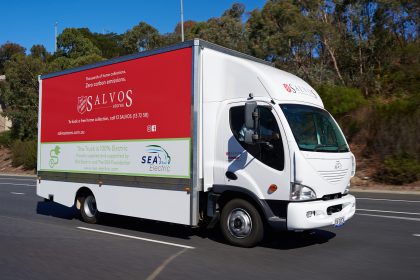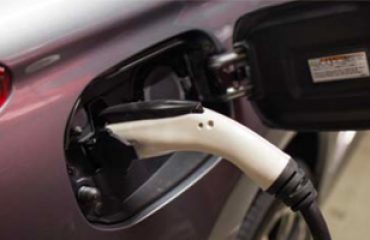
Greener fleet: SEA Electric’s truck donated to the Salvos might be an early prototype, but it is expected to easily manage the charity’s suburban delivery runs and save two tonnes in CO2 emissions each year.
SEA Electric donates EV truck to Salvos Stores as Australia Post trials Fuso eCanter
THE Salvation Army and Australia Post have added a full-electric truck to their respective vehicle fleets to assess the viability of switching to a zero-emissions powertrain for urban delivery services.
For the Salvos, Australian EV powertrain specialist SEA Electric has donated one of its early prototype trucks – based on a Smith Electric Vehicles ‘Newton’ model with an Avia chassis – that makes Salvos Stores the first charity retailer in Australia to have an electric vehicle on its distribution fleet.
Australia Post, meanwhile, has become the first Australian company to trial Fuso’s eCanter, which uses a powertrain developed by parent company Daimler and is billed as the world’s first electric truck from a major automotive OEM.
Speaking to GoAuto at the handover ceremony of the SEA-badged medium-duty truck at its Noble Park distribution centre in Melbourne’s outer southeast last week, Salvos Stores acting managing director Eva Zelos and general manager of operations Neil Lund said the electric truck would be a significant testbed as the organisation looked to develop a purchasing policy for its delivery vehicle fleet.
The national fleet stands at 84 vehicles working out of 14 distribution centres and servicing 331 stores across Australia. The vehicles make runs between household collection points and the distribution centres and stores, as well as deliveries to customers via its burgeoning Op Shop Online run through eBay.
Mr Lund acknowledged that the SEA vehicle, which is worth an estimated $50,000, was an early prototype which means its driving range is limited to about 150km between charging, but said it would be used within its limitations and posed no issues of range anxiety given its workload typically involved only short distances, stop-start driving (allowing for battery regeneration) and back-to-base runs.
Recharging to a “useable level” should take about six hours from the distribution centre’s three-phase power supply, and Mr Lund said there was scope for the vehicle to be upgraded with one of SEA Electric’s constantly evolving drivetrains that offer more power and a circa-300km range.
Currently, the electric motor produces 120kW.
“When we say it’s a testbed vehicle, we know that there are limitations to the range, and we know that we would look forward to greater range with (future) new vehicles,” he said.
Ms Zelos added that, as it stands, the truck should help the organisation reduce its CO2 emissions by about two tonnes each year. She also said that in Victoria alone, Salvos Stores made more than 40,000 deliveries a year.
Over at Australia Post, the Fuso eCanter joins a fleet of more than 2200 EVs on the road with the national postal service – primarily electric postie bikes and trikes making ‘last-mile’ deliveries – and will operate in Sydney’s CBD “over the coming weeks” before being returned to the manufacturer “for internal evaluation”.
As GoAuto has reported, Australia Post has also previously run trials with electric vans in Australia, including Renault’s Kangoo EV.
Australia Post’s general manager of transport and aviation, James Dixon, said the eCanter trial would “gauge the vehicle’s suitability for the business during customer pickups and deliveries” as part of its commitment to making its operations more efficient and sustainable, including through the use of electric vehicles.
Daimler has built about 150 Fuso eCanters and conducted trials in various cities including London, Tokyo, New York, Berlin, Amsterdam, Paris and Lisbon.
The 7.5t truck is powered by a 115kW/390Nm AC synchronous electric motor and uses six Mercedes-sourced 360V 82.8kWh lithium-ion battery packs that offer a driving range of about 100km.
It can be charged to 80 per cent capacity in less one hour with a Type 2 charger, and needs eight hours for a full recharge using a standard domestic socket. READ MORE
Article by TERRY MARTIN, GoAuto News, 23 Sep 2019




